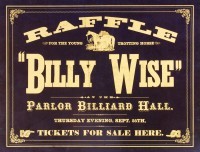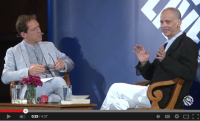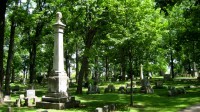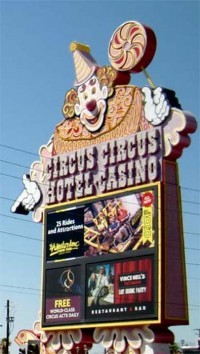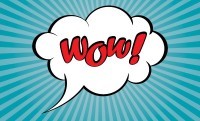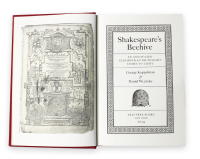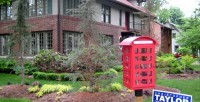Printed American broadsides of the 18th and 19th centuries—what we might think of today as “posters”—were an important public means of spreading news and information within a community. A broadside might print a political manifesto, a religious sermon, a military declaration, news of a great battle, or a Presidential proclamation. A broadside might advertise a newly arrived shipment of goods or a new production of a play or circus. Merchants and inventors used broadsides to sell their wares or to attract investors. American broadsides fall under the broader category of historical ephemera—printed items created and intended only for temporary, fleeting use. These ephemeral artifacts documented the beliefs, activities, and concerns of a very specific time and place in American history. Eighteenth and nineteenth century American broadsides were public notices and announcements; mass media in an age where the “worlds” in which men and women lived were much smaller and less connected. From an American broadside circa 1854 printed in Charleston, South Carolina. Illustrated broadsides from 18th and 19th century America are desirable, as are broadsides lettered in color. Unlike a book, a broadside's authorship often was anonymous or obliquely suggested. This broadside from the American Civil War denounces Copperheads, those individuals whom's loyalty to the Union cause was of dubious nature. (Image detail) By the 20th century, printing technologies in America had grown ... [more American Broadsides, History on a Sheet of Paper]
The making of catalogs is on my mind tonight. I just put my own nineteenth catalog to bed — it left for the printer's an hour ago, a massive thing by my standards; over a hundred pages, just shy of two hundred-fifty items, all pictured. Research and cataloguing aside, lots of work goes into a catalog like that. The last two weeks at Lorne Bair Rare Books have been spent frantically photographing, photo-editing, laying-out, and proofreading. None of which I would describe as traditional “booksellerly” vocations — in fact, I'm not sure a single new book has gotten catalogued around here in the interval — but there we are. The New Antiquarian (if I may be so bold) finds himself going to great lengths these days to sell a book. Not that there's anything “new” about rare book catalogs! For a few hundred years they were the standard medium through which antiquarian books were distributed. But then (you've heard this one before) came the internet. Not everyone stopped printing catalogs when on-line bookselling came to prominence, but many did. Those of us who continued putting them out were looked on with a bit of suspicion by some of our more progressive colleagues, as though we weren't quite getting with the program. Now, it seems, there's a bit of a resurgence in printed catalogs — I'm seeing more of them lately, many from dealers new to the scene. Clearly there's something up. I'm not certain exactly how many of my colleagues issue printed catalogues, but I'm cer... [more What My Friends Think I Do: Part II In A Series]
I'm from Maryland and John Waters is my favorite famous hometown boy. (I'm reading his new hitchhiking memoir Carsick now.) I serendipitously met him once at a gallery in P-town and he was just as engaging one-on-one as he is in this video—a recent interview from the LIVE from the NYPL series. Unsurprisingly, Waters is a great story-teller and in it, he talks about his book collection (think counter-culture and LGBT literature with punny titles) and name-checks our friends at Bolerium Books. He also discusses the problems institutions face when collecting material that is no longer "PC" or otherwise considered distasteful. -Susan Benne [more John Waters, Charm City Book Collector]
In one of his portraits of the convivial octogenarian turf journalist Colonel John R. Stingo, A. J. Liebling writes, Like most people of pronounced seniority he reads the obituary pages with attention, and had a morning of quiet triumph last winter when two insurance shamans, a past president of the Actuarial Society of America and the vice-president of a major company, died on the same day, aged sixty-two and fifty-four respectively. 'I bet they avoided excitement, late hours, high blood pressure, tasty food and intoxicating liquors and had themselves periodically examined with stethoscopes, fluoroscopes, spectroscopes and high-powered lenses,' the Colonel said. 'The result was inevitable and to be expected, the result of morbid preoccupation. The anxious fielder drops the ball.' Most antiquarian booksellers of my acquaintance shun morbid preoccupation. At book fairs and other venues where booksellers gather, one often finds colleagues gathered around the groaning board or even on occasion congregated in rooms where one may conveniently rest a foot upon a brass rail. Despite my own best efforts, a bit of the morbid preoccupation will on occasion creep in upon me; to combat the cumulative effects of the collegial life I will lace up my running shoes and set off at a lumbering trot of self-improvement through the streets of Ann Arbor. And when the cankering cares of business seem especially grim, I make certain my route takes me up through Ann Arbor's Forest Hill Cemetery. It ... [more The Perils of a Morbid Preoccupation.]
Where do you start with a place like Vegas? Bally's Hotel and Casino is hosting the 2014 Moose International convention and dealing with a chronic shortage of aquatic plant life, willow shoots, and other forage. Hairy guys with backwards baseball caps. Old men and their leisurewear. Fatties in mobile chairs work away, tethered to slot machines. A Bally's credit card at the other end of the line drips the money in and out. The tether prevents the card from being stolen, lost, or forgotten. Sorry, sir, no photographs. What is the plural of Moose ? Do the International Moose employ it? There is a convention in noir cinema – someone has slipped the detective a mickey, or the alcoholic is in the middle of a lost weekend, or an innocent party has received a life altering shock. “Sorry, honey. I'm leaving you for a Moose.” The movies represent this state of psychic distress by means of flashing lights, carnival midway noises, and squirming, spinning shapes. Everything is out of focus. Voices come in and out, layered with hallucinogenic visuals and shreds of pop songs. Places and times jam together like a freeway pileup. This is the lobby at Bally's Las Vegas Hotel and Casino. The mickey is optional, but the lights, noises, voices, and ghastly visuals surrounding me leave no doubt that I'm in someone's grade B detective flick, or lost weekend, or that the life altering shock is Las Vegas itself. A line in one of my aural hallucinations croons, “It's just too marvelous, too ma... [more Not This Time]
Member Chic Goldsmid reports having shipped (USPS, insured) a box of books to the District of Columbia. The box arrived today, having been opened and without the two books below: RICHARD WILBUR. Anterooms: New Poems and Translations. Boston: Houghton Mifflin Harcourt, 2010 - Cloth. In jacket. Warm, personal Wilbur inscription to his friend and colleague, Robert Mezey. ALLEN GINSBERG. Fall of America: Poems of These States 1965-1971.SF: City Lights, (1972). In original printed paper wrapper. Customer uncertain that it is a first. Apparently also personally inscribed to Mezey and family. Please contact us or Chic if you know the whereabouts of these items. Charles Goldsmid: goldsmid@mindspring.com or (909) 625-2543. [more Missing: Poetry Inscribed Richard Wilbur & Allen Ginsberg]
Welcome to the new ABAA website. We hope you'll find it an exciting place to explore rare books, find items to purchase, and meet some of the best booksellers in the US. The site is packed with new features and possibilities. Many of these features are there to emphasize the individual booksellers, all of whom are members of the Antiquarian Booksellers' Association of America and are held to the strict standards of the ABAA Code of Ethics. Throughout the site, the booksellers are front and center, giving you more information about the seller on the item pages, more details on the bookseller pages, and a richer sense of what booksellers are up to on the blog and through various social media. The ABAA blog is brand new as well, now called The New Antiquarian, and featuring multiple contributors. Booksellers have richly different backgrounds and knowledge, so it only makes sense that we would want more than a single point of view on the new blog. We start with a number of booksellers who have proven themselves as interesting and engaging bloggers, but you can expect more voices in the future, and guest blogs from people outside of the ABAA, including Special Collections Librarians, book arts craftsmen, private collectors and more. While we've worked hard to create the best site we can, inevitably there will be a few bugs, so if you find one, please report it to the email address below. bugreport@abaa.org If you haven't already, we hope you will create a user account, so it will ... [more A Brand New ABAA Website!]
On June 17th, join ABAA members George Koppelman and Dan Wechsler for an evening at Swann Auction Galleries, where they will be speaking about their recently published book Shakespeare's Beehive and recounting "the story of how two antiquarian booksellers would acquire and conclude that it is William Shakespeare's own personal dictionary." Full details below. [more Lecture on Shakespeare’s Beehive at Swann Galleries]
The stretch from 1833 up through early 1834 was a pretty good run for the Chester County (Penna.) Cabinet of Natural Science. The museum published its seventh report in April 1834, and while its pages note some of the natural phenomena sprung upon the community in the previous year—like the “copious 'meteoric shower'” observed on the night of November 12, 1833—the report also devotes a good chunk of space to what museum annual reports have continued to do up through the present day: thanking its donors. The Chester County (Penna.) Cabinet of Natural Science by the spring of 1834 could boast that it possessed the head and bill of an albatross (with the jawbone of a dolphin thrown in for good measure) given to them by Captain Thomas Dixey, while Philip Sharpless had made a gift of his small collection of lead and iron musket balls gathered from the Brandywine battlefield. An adventuresome Dr. Carrey had wandered even further afield and such stony fruits of his travels as he carried back were of sufficient merit to prompt the museum to thank him for his “valuable collection of minerals from Arkansaw Territory.” My copy of the 1834 report now reposes on the shelves of a private collection. Those impelled to delve with greater attention into the doings of the Chester County (Penna.) Cabinet of Natural Science might consult a run of the institution's reports from 1828 through 1849 at Yale's Beinecke Library (itself no mean cabinet of printed wonders). The history of suc... [more Articles of Great Value in Small Compass]
The Library Company of Philadelphia, “America's oldest cultural institution,” traces its history back to the good offices of Benjamin Franklin, who was instrumental in establishing the Library Company in 1731. The Library Company has a storied history of course—it served as the first Library to Congress, was for years the largest public library in the United States, and today houses a first-rate collection with a number of notable strengths. It also seems to inspire a certain amount of devotion. I recently paid a visit to the Library Company and as we waited in the lobby to meet with the Curator of Printed Books, Rachel D'Agostino, I noticed the attractive and--to my untrained eye--evidently funerary marble slab over next to the reception desk. Rachel later explained that this slab in fact marks the graves of library benefactors James Rush (1786-1869) and his wife Phoebe Ridgway Rush (1799-1837). After his death in 1869, the childless and one might say eccentric James Rush gave his library and papers to the Library Company, and made a “generous bequest” that included provision for the purchase of land and the funds to construct a new library building—as well as restrictions that included such stipulations as Let it not keep cushioned seats for time-wasting and lounging readers, nor place for every-day novels, mind-tainting reviews, controversial politics, scribblings of poetry and prose, biographies of unknown names, nor for those teachers of disjointed thinking, ... [more Friends of the Library]


